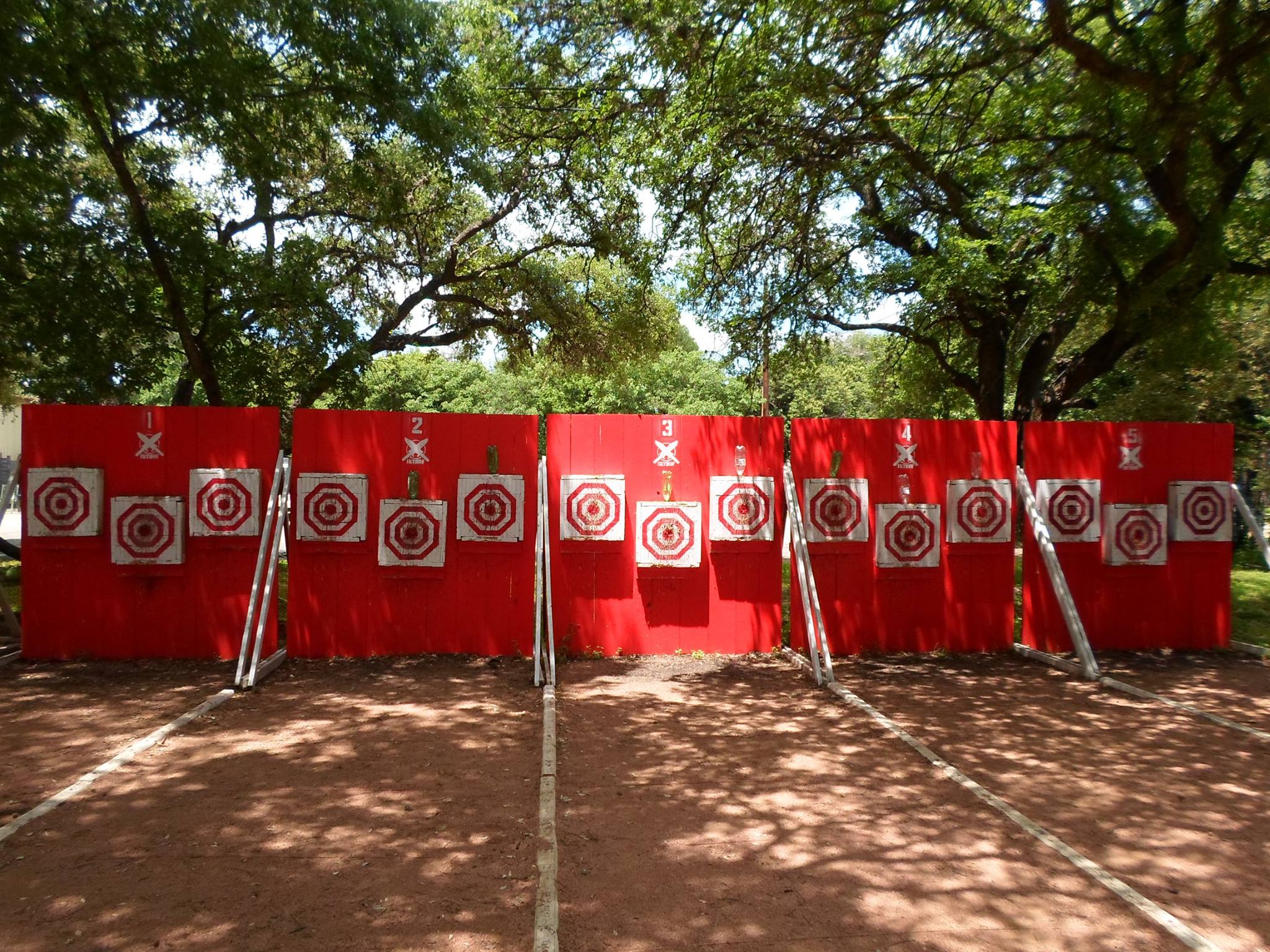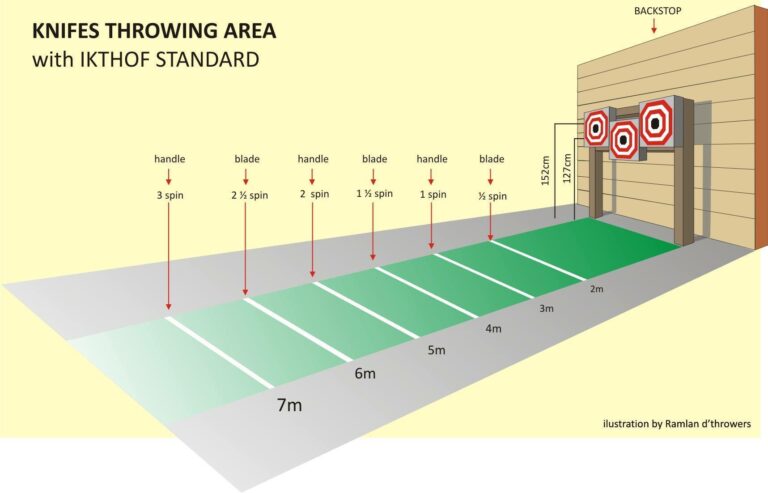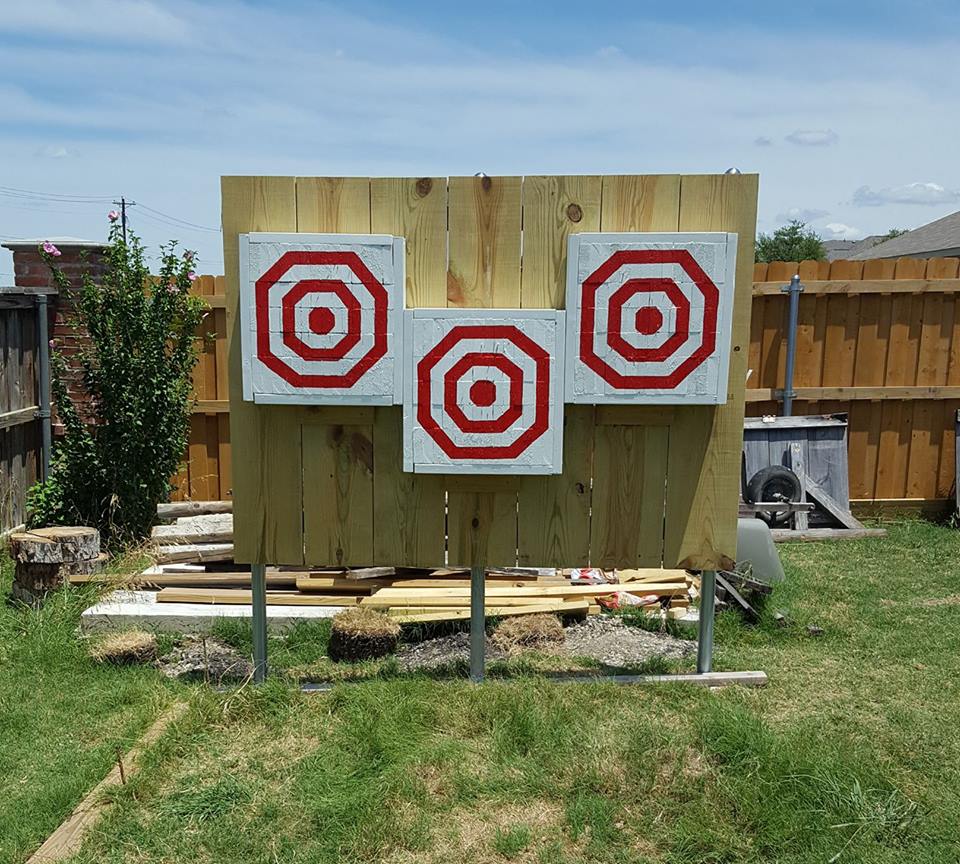ANSWERS TO FREQUENTLY ASKED IKTHOF RANGE QUESTIONS
 The range is setup the same for all ikthof tournaments in regards to lanes, targets and distance markers.
The range is setup the same for all ikthof tournaments in regards to lanes, targets and distance markers.
IKTHOF Standard targets are Octagonal Targets with a 10.16 cm (4 inches) bullseye. The bullseye is surrounded with concentric rings 5.08 cm (2 inches) wide. Scoring on this target starts at 5 points for the bullseye reducing by one point for each ring. Anything stuck in the target outside of the ringed area is considered a 0. You can have the targets touching or not touching dependent on the backboard. They can be hand made out of 4x4's or any other type end grain board of your design or tree rounds as long as the rings are correct and fit on the face of the target.
Scoring:
The IKTHOF standard of scoring will award points based on where the metal of the blade touches the paint
(for knives, the tip of the knife must be embedded for the knife to count as a legal stick).
In the case that a knife or tomahawk blade crosses between multiple scoring rings, the highest point value will be awarded. NOTE: in the case of a dispute between the thrower and scorer, the range master will be called to decide the final outcome of scoring. If it is obvious that a hawk is in a certain scoring area but it is deep the score keeper can double check the score by slowly removing the hawk, not the thrower but the score keeper. Ideally it would be best if another score keeper or range master was present to witness the removal for validation if the thrower tries to contest the score keepers ruling. If it takes too long to ascertain the point the thrower gets the higher point.
Targets:
3 standard targets are required for an IKTHOF compliant lane. These targets are mounted with the center of the bullseye at 152 cm (60 inches), 127 cm (50 inches) and 152 cm (60 inches) from the ground.
Lanes
Marked along the lane will be markers from 2 meters back to a minimum of 9 meters. Although not required, imperial markers for feet and inches are also allowed.
Range Master
During a standard competition, a designated range master will observe and maintain safety. No thrower shall commence throwing until the range master has called that the range is open or clear for throwing. When open, no person shall approach the targets until the range master says announces it. When all knives or hawks have been thrown, the range master will call for the range to be closed. At this point, it is safe to approach the targets for scoring and to retrieve your knives or hawks.
Amateur:
You will throw from behind a foul line which is 2 meters all the way up too 5 meters. Your rotation will be starting with 1/2 spin then 1 spin from 3 meters, then 1 1/2 spin from 4 meters and then 2 spin from 5 meters. You must throw the correct rotation from behind the foul line.
Pros:
You will throw from behind a foul line which is 3 meters all the way to to 9 meters. Your knife rotation will be starting with 1 spin from 3 meters, then 1 1/2 spin from 4 meters an then 2 spin from 5 meters, 2 1/2 from 6 meters, and then 3 spin from 7 meters. You must throw the correct rotation from behind the foul line.
Hawk distances are a little different, they are the same as far as rotation being 1 spin to 3 spin just the distances are different. The foul line distances you must be behind are 3 meters 1 spin, 4 meters 1 1/2 [which is handle up in the target], 5 meters 2 spin, 7 meters 2 1/2 spin, and 9 meters 3 spin.
|


|
We Throw together and walk together!
This is a reminder that you are not allowed to retrieve your axe/hawk or knife until the range master says so.
You especially NEVER THROW if someone is at the targets in a lane next to you,EVER!.
The main rule is we throw together and walk together on all lanes because tournament ranges are different than a bar setup. There is no fence between lanes and most tournaments are usually
outdoors. All tournaments no matter the organization are run with the same very strict rule of no live edged knife, throw together, walk
together and there has never been an incident that I know of since the 1970’s with any event.
|
|